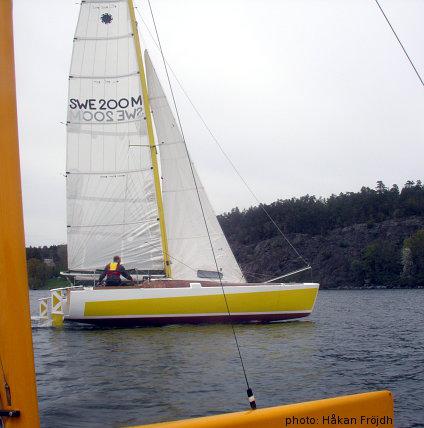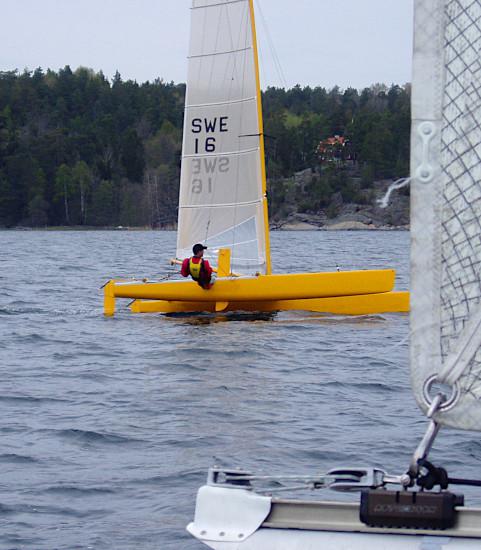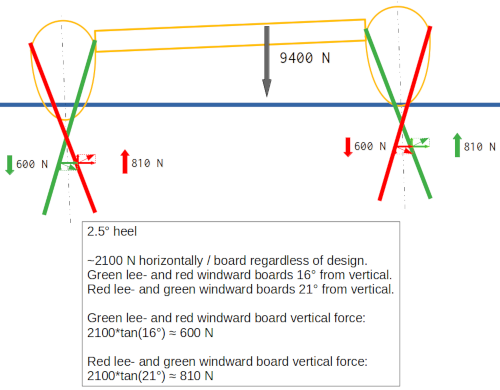Daggerboards

Introduction
Daggerboards, pivoting centre boards or fixed keels are use to limit leeway. The efficiency of these leeway preventers has a big impact on our ability to go to windward. On other courses there is less need for leeway preventers and dead down-wind they are just drag. Well, they still help with traction but only small areas are needed for this. From this follows that daggers and pivoting boards have a big advantage over fixed keels. Since they can be retracted there is no need for a compromise between windward and downwind performance.
Below I will assume that 'optimum' windward performance is aimed for and the boat is strong enough to handle the loads generated by the boards. This is far from always the case and if it is not both board 'size' and structural engineering must be adjusted accordingly.
Priorities
Here is my rant on what is important and what is merely icing on the cake when it comes to designing dagger boards.
- Make them big enough!
-
If the boards are too small, they must work with a large Cl (lift coefficient). A large Cl means high induced drag. Not only is this inefficient but manoeuvring will suffer. The boat will be slow out of tacks and every so often the boards will stall after a tack. (Down-load this document for more on board-size.)
- High aspect ratio is better!
-
By increasing AR (aspect ratio) you can decrease drag more than by any other measure. Keep an eye on the structural aspect of this though. Handling might get tricky for extreme ARs.
- Plan-form:
-
There is more to gain here than from optimising the section. But is it worth it? A fancy plan-form is more time consuming to build than a simple rectangular one. Note that quite a few hot racers like Cogito, RC-27 … make do with rectangular boards. All these have really high-AR foils (low induced drag to start with) and Bill Roberts (RC27 etc.) always uses forward swept daggerboards. This is supposed to decrease induced drag. Cogito and others have boards swept the other way. This reduces board/hull interference and drag due to wave-making. I guess the jury is still out on sweep angle.
A nice compromise if you want to do something about the plan-form is to keep the trailing edge straight and make the leading edge straight apart from the lowest part which follows a quarter circle arc. A not too good photo of this is shown below.

- Location in hull:
-
For an all-out racing beach cat like the A-cat above it is 'natural' to locate dagger boards on the centre-line of the hull. For a larger boat with accommodation in the hulls one wants to move the dagger boards out of the way. There are two options. Tilting the boards inboard or outboard.
On Scarlattikvarten the boards are tilted inboard. This is what the plans told us to do. The main advantage of this is ease of handling.
Boards tilted towards the outside of the boat are found on the Mycat designed by Lars Oudrup and the Firebird cat designed by Martyn Smith. This design improves stability and reduces lee hull depression some. How this works is shown in the figure below. Numbers and proportions come from Scarlattikvarten.

- Choosing a wing section:
-
Let me start with stating that it is important to use a proper wing section. Just making something that looks like wing section is not a good idea. Such sections are not only draggy. They are also prone to stall and/or to ventilate. For rudders this can be dangerous as you may loose control at the wrong moment.
Spending a lot of time and energy on 'optimising' the wing section should be a luxury activity once all above have been ticked off. Good old NACA0012 is not a bad default choice. At low speed (low RE-numbers (Reynolds numbers)) it is 80% laminar and hard to beat according to Mark Drela (of Daedalus, Decavitator and X-foil fame).
On the other hand, it is not harder to build other sections that are less prone to ventilate and that are better at higher RE. Yes, laminar sections are used (I use such sections for instance) but try to look for one that is insensitive to perturbations in shape and without pressure (suction really) extremes. You will pay with higher section drag (in the computer) but it will work better in reality. One more thing on this: There is no reason for going thin (below 11%) from a drag point of view. You will only get structural problems by doing that.
What about asymmetric foil sections for dagger boards? In my view this adds almost nothing to the performance of the boat but it does add extra work in each tack. I have tried to summarise the symmetric vs. asymmetric situation in this document.
Strength and stiffness
My view is that there are really no short-cuts when it comes to structural engineering. Either you do it properly or you don't. Here are eight pages on the structural engineering of dagger boards. It is not a complete tutorial but a brief introduction.
"Regardless of what you have been told, recreational use of mathematics is harmless" /Peter Olofsson